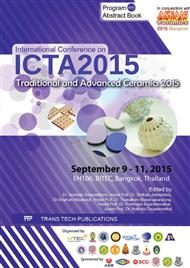p.65
p.71
p.76
p.81
p.87
p.92
p.97
p.103
p.109
Powder Injection Molding of Mullite: The Study of Binder Dissolution Behavior during Debinding Step Using Statistical Methods
Abstract:
The purpose of this work is to use the statistical methods including linear regression and statistical hypothesis test to study the dissolution behavior of polyethylene glycol (PEG), a water-soluble binder, during debinding step of the green specimens of mullite formed by powder injection molding (PIM). Two systems of composite binders were investigated including (A) 80 wt% polyethylene glycol (PEG) and 20 wt% polyvinyl butyral (PVB) and (B) 78 wt% PEG, 20 wt% PVB, and 2 wt% steric acid (SA)The lab-scale plunger type PIM machine was used to prepare the green specimens consisting of mullite powder and the composite binder. The possible solid loadings of the green specimens that could be prepared by this machine were 50, 52, and 54 vol% mullite (50, 48, and 46 vol% binder). The debinding was done by soaking the green specimens in the warm water at 40 or 60 oC to remove PEG. At level of significance 0.05 for statistical analysis, the dissolution behavior of PEG can be fitted with Avarami equation. In addition, from the Avarami equation obtained from each experimental condition, the dissolution rate of PEG was independent of the parameters used in this study including solid loading in the green specimens, water temperatures for debinding, and composite binder systems.
Info:
Periodical:
Pages:
87-91
Citation:
Online since:
May 2016
Price:
Сopyright:
© 2016 Trans Tech Publications Ltd. All Rights Reserved
Share:
Citation:


